
Business Statistics
Pearson
978-0-13-078201-4 (ISBN)
- Titel erscheint in neuer Auflage
- Artikel merken
Preface.
1. Introduction and Data Collection.
Why a Manager Needs to Know about Statistics. The Growth and Development of Modern Statistics. What Readers of This Textbook Need to Know about Microsoft Excel and PHStat or Minitab, or SPSS®. Why Data are Needed. Sources of Data. Types of Data. Design of Survey Research. Types of Sampling Methods. Evaluating Survey Worthiness.
2. Presenting Data in Tables and Charts.
Organizing Numerical Data. Tables and Charts for Numerical Data. Graphing Bivariate Numerical Data. Tables and Charts for Categorical Data. Tabulating and Graphing Bivariate Categorical Data. Graphical Excellence.
3. Numerical Descriptive Measures.
Exploring Numerical Data and Their Properties. Measures of Central Tendency, Variation, and Shape. Exploratory Data Analysis. Obtaining Descriptive Summary Measures from a Population. The Coefficient of Correlation. Pitfalls in Numerical Descriptive Measures and Ethical Issues.
4. Basic Probability.
Basic Probability Concepts. Conditional Probability. Ethical Issues and Probability.
5. Probability Distributions.
The Probability Distribution for a Discrete Random Variable. Covariance and Its Application in Finance. Binomial Distribution. The Normal Distribution. Evaluating the Normality Assumption.
6. Sampling Distributions and Confidence Intervals.
Sampling Distributions. Introduction to Confidence Interval Estimation. Confidence Interval Estimation of the Mean (s Known). Confidence Interval Estimation of the Mean (s Unknown). Confidence Interval Estimation for the Proportion. Determining Sample Size. Confidence Interval Estimation and Ethical Issues.
7. Fundamentals of Hypothesis Testing: One-Sample Tests.
Hypothesis-Testing Methodology. Z Test of Hypothesis for the Mean (s Known). One-Tail Tests. t Test of Hypothesis for the Mean (s Unknown). Z Test of Hypothesis for the Proportion. Potential Hypothesis-Testing Pitfalls and Ethical Issues.
8. Hypothesis Tests for Numerical Data from Two or More Samples.
Comparing Two Independent Samples: Tests for Differences in Two Means. F Test for Differences in Two Variances. Comparing Two Related Samples: Tests for the Mean Difference. The Completely Randomized Design: One-Way Analysis of Variance.
9. Hypothesis Tests for Categorical Data From Two or More Samples.
Z Test for Differences between Two Proportions. x2 Test for Differences between Two Proportions. x2 Test for Differences in More Than Two Proportions. x2 Test of Independence.
10. Simple Linear Regression.
Types of Regression Models. Determining the Simple Linear Regression Equation. Measures of Variation. Assumptions. Residual Analysis. Measuring Autocorrelation: The Durbin-Watson Statistic. Inferences about the Slope and Correlation Coefficient. Estimation of Mean Values and Prediction of Individual Values. Pitfalls in Regression and Ethical Issues. Computations in Simple Linear Regression.
11. Multiple Regression Analysis.
Developing the Multiple Regression Model. Residual Analysis for the Multiple Regression Model. Testing for the Significance of the Multiple Regression Model. Inferences Concerning the Population Regression Coefficients. Testing Portions of the Multiple Regression Model. The Quadratic Regression Model. Dummy-Variable Models. Collinearity. Model Building. Pitfalls in Multiple Regression and Ethical Issues.
12. Time Series Forecasting.
The Importance of Business Forecasting. Component Factors of the Classical Multiplicative Time-Series Model. Smoothing the Annual Time-Series. Least-Squares Trend Fitting and Forecasting. Autoregressive Modeling for Trend Fitting and Forecasting. Choosing an Appropriate Forecasting Model. Time-Series Forecasting of Monthly or Quarterly Data. Pitfalls Concerning Time-Series Analysis.
13. Statistical Applications in Quality and Productivity Management.
Quality and Productivity: A Historical Perspective. Deming's 14 Points: A Theory of Management by Process. The Theory of Control Charts. Control Chart for the Proportion of Nonconforming Items—The p Chart. The Red Bead Experiment: Understanding Process Variability. Control Charts for the Range (R) and the Mean.
| Erscheint lt. Verlag | 4.9.2002 |
|---|---|
| Sprache | englisch |
| Gewicht | 1350 g |
| Themenwelt | Mathematik / Informatik ► Mathematik ► Finanz- / Wirtschaftsmathematik |
| Mathematik / Informatik ► Mathematik ► Statistik | |
| ISBN-10 | 0-13-078201-7 / 0130782017 |
| ISBN-13 | 978-0-13-078201-4 / 9780130782014 |
| Zustand | Neuware |
| Haben Sie eine Frage zum Produkt? |
aus dem Bereich



